Species Transport Training Package, Intermediate Part 1, 10 Practical Exercises
Original price was: $1,730.00.$289.00Current price is: $289.00. Student Discount
Species Transport – ANSYS Fluent Training Package, 10 Practical Exercises for INTERMEDIATE Users (Part-I)
Click on Add To Cart and obtain the Geometry file, Mesh file, and a Comprehensive ANSYS Fluent Training Video.To Order Your Project or benefit from a CFD consultation, contact our experts via email ([email protected]), online support tab, or WhatsApp at +44 7443 197273.
There are some Free Products to check our service quality.
If you want the training video in another language instead of English, ask it via [email protected] after you buy the product.
Description
Species Transport – ANSYS Fluent Training Package, 10 Practical Exercises for INTERMEDIATE Users (Part-I)
This CFD training package is prepared for INTERMEDIATE users of ANSYS Fluent software in the Species Transport area. You will learn and obtain 10 practical exercises including comprehensive training on how to simulate medium projects. The achieved knowledge will enable you to choose the most appropriate modeling approaches and methods for applications and CFD simulations.
This package trains the necessary proficiency you will require to start doing average computational fluid dynamics (CFD) Species Transport simulations on your own using Ansys Fluent software. Qualified training movies and comprehensive CFD concept explanations, including setup, solution, results, and all perspectives of carrying out CFD simulations in ANSYS Fluent.
Coronavirus (COVID-19)
In project number 1, Ansys Fluent software used two-way DPM to simulate human Cough virus particles in the Coffee Shop. According to this definition of injection, human cough virus particles are physically expelled from the patient’s mouth by water droplets evaporating in space. Following this method and the suitable formulation, the values related to the minimum, maximum, and average diameter size determine the exponential parameter of the spread and the number of diameters per injection. It should be noted that the drop mode is applied when the species transport model is also activated.
The purpose of project number 2 is to investigate the ability of coronavirus particles to spread inside the Bank from a bank customer to a healthy bank employee. This simulation process is performed in two different modes. In the first modeling, no cover is located between the client and the bank employee to show the virus’s transmission power. In the second model, an attempt is made to make a thin plastic cover between them. For the present simulation, the discrete phase model (DPM) is used; Because this model allows us to study a mass of particles discretely or bit by bit in a continuously fluid space.
The Elevator Cabin is one of the most important spaces in the discussion of coronavirus disease; Because usually, some people with the shortest possible distance are placed in a small space with a not very strong ventilation system. In project number 3, based on the CFD method, an attempt has been made to simulate the coronavirus particle dispersion from the carrier patient’s cough inside an elevator cabin.
The purpose of project number 4 is to investigate the diffusion power of virus particles inside the Car. For the present simulation, the discrete phase model (DPM) is used; Because this model allows us to study a mass of particles discretely or bit by bit in a continuously fluid space.
Combustion (Species Transport)
Project number 5 is about the combustion inside a Boiler. Boilers are pressurized tanks that carry out the boiling or heating fluid. Boiling is a process that brings the temperature of a fluid to the boiling point. Therefore, the combustion reaction must occur inside these boilers. The combustion reaction occurs in the computational zone of the boiler, and the desired species are defined using the species transport model. Nine different species are defined to define the combustion reaction, and five combustion reactions between these species are defined as Volumetric.
Project number 6 is the CFD simulation of combustion in a bluff-body mild burner. In fact, a burner is a device that combines a certain amount of air with fuel in a safe space, converting fuel energy into heat energy, which also produces some gas as a result of this combustion process. The flame produced in the burner is transmitted to the interior of the chamber by two methods of convection and radiation. Therefore, the Radiation (DO) model should also be used in the present model. Also, since the combustion process takes place within the combustion chamber, the species Transport model is also used.
Project number 7 simulates a two-step mechanism of combustion in a gas flare in the presence of wind flow. The flare system, also known as a gas flare, is a combustion device used in industrial units such as oil and gas refineries and the production of oil and gas wells, especially on offshore platforms. Gas flares are responsible for burning the natural gases released during oil extraction in a completely controlled manner.
Fuel Cell
Project number 8, which has been done by CFD numerical simulation method, A fuel cell is simulated. Fuel cells generate electricity through a chemical reaction and are less polluting than other power generation methods. In this project, a fuel cell is simulated from the PEMFC model.
Desalination
Project number 9 investigates the performance of a solar still thermal desalination unit. The present model consists of a small chamber with a sloping glass surface at the top. The solar heat passes through the glass to the surface of the water in the enclosure and causes surface evaporation (applying a UDF for surface evaporation). The resulting vapor impacts the cold glass surface and undergoes a distillation process. Pure water from hot vapor distillation moves down the slope of the glass plate and discharges as pure water.
Decomposition
In project number 10, according to the geometry, the design and grid generation has been done. The combination of DPM (discrete particle method) and species transport methods was used to investigate the decomposition effect of magnesium oxide particles. This reaction is exothermic in the reactor chamber and increases its temperature. From the left inlet, argon gas enters at a temperature of 300 ° C. From the right inlet, argon gas enters at a temperature of 700 ° C with the injection of magnesium oxide particles at the same temperature.
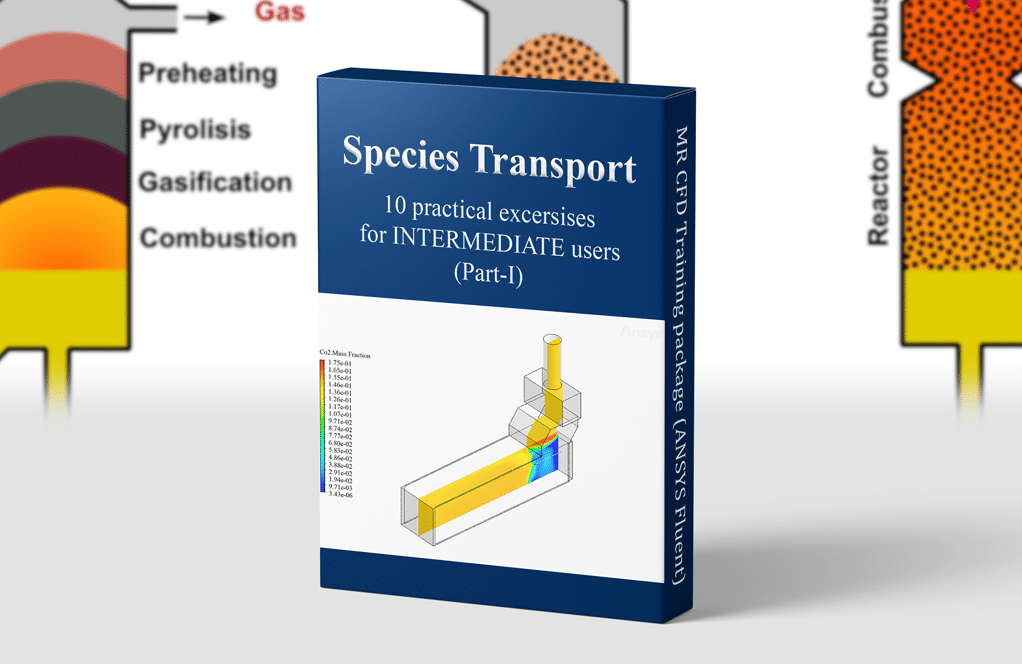

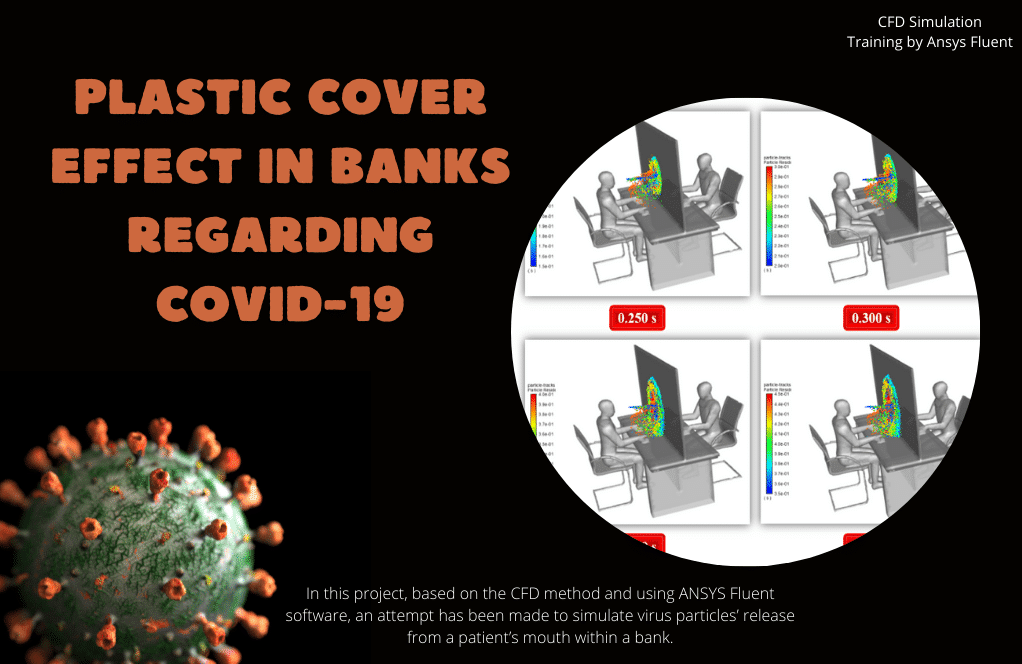
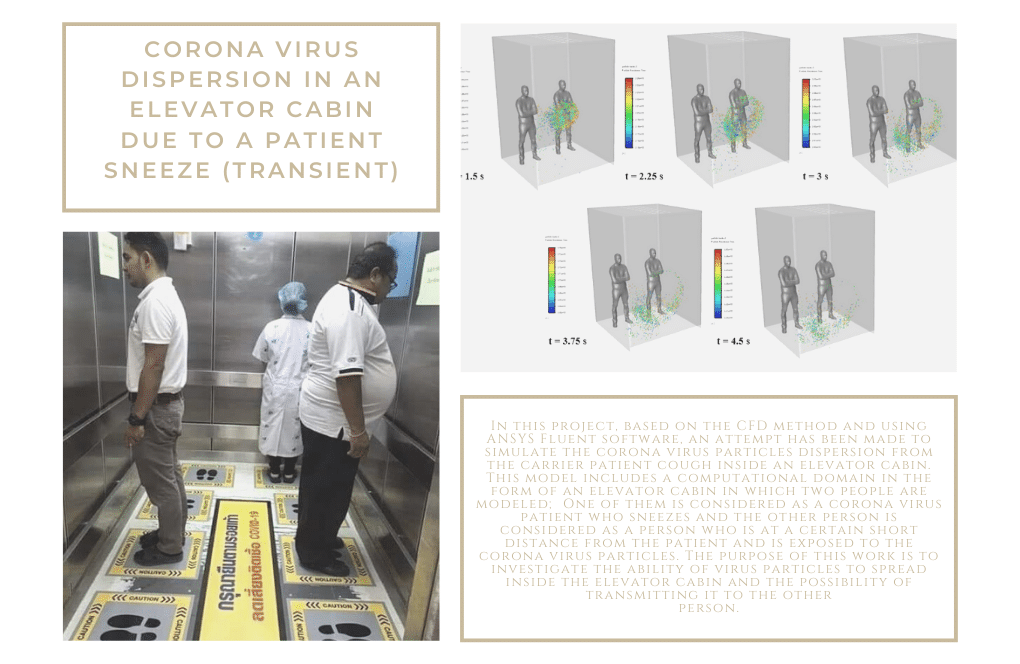

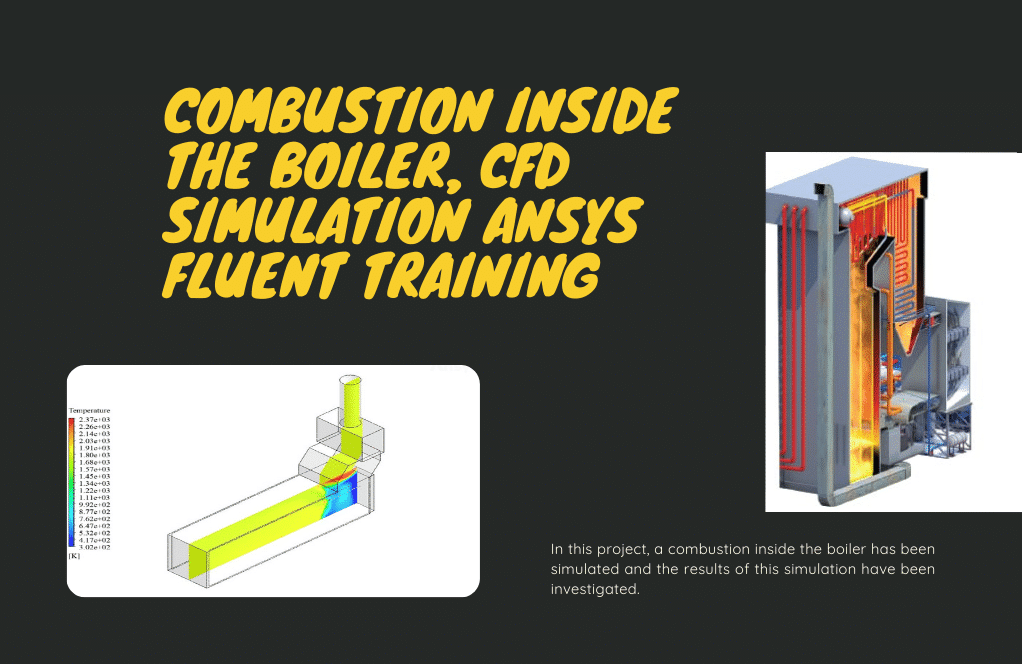
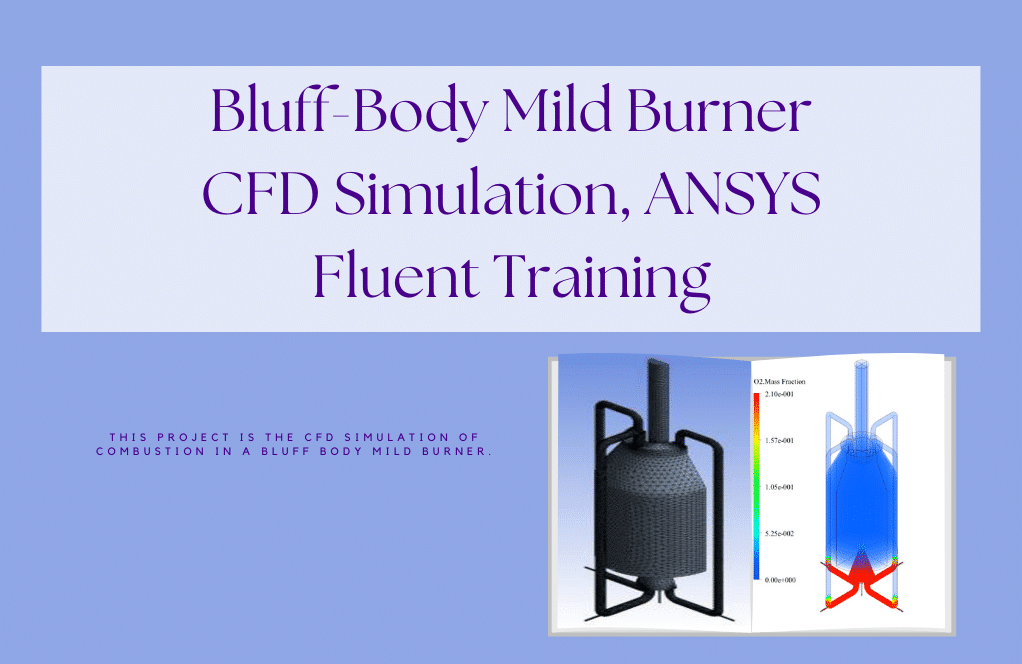
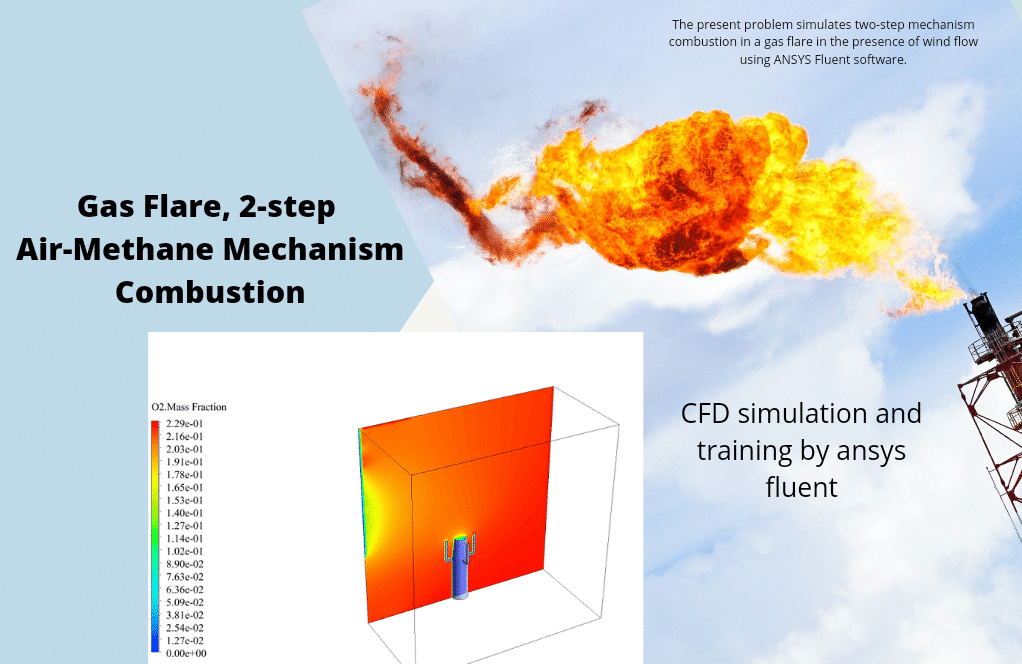
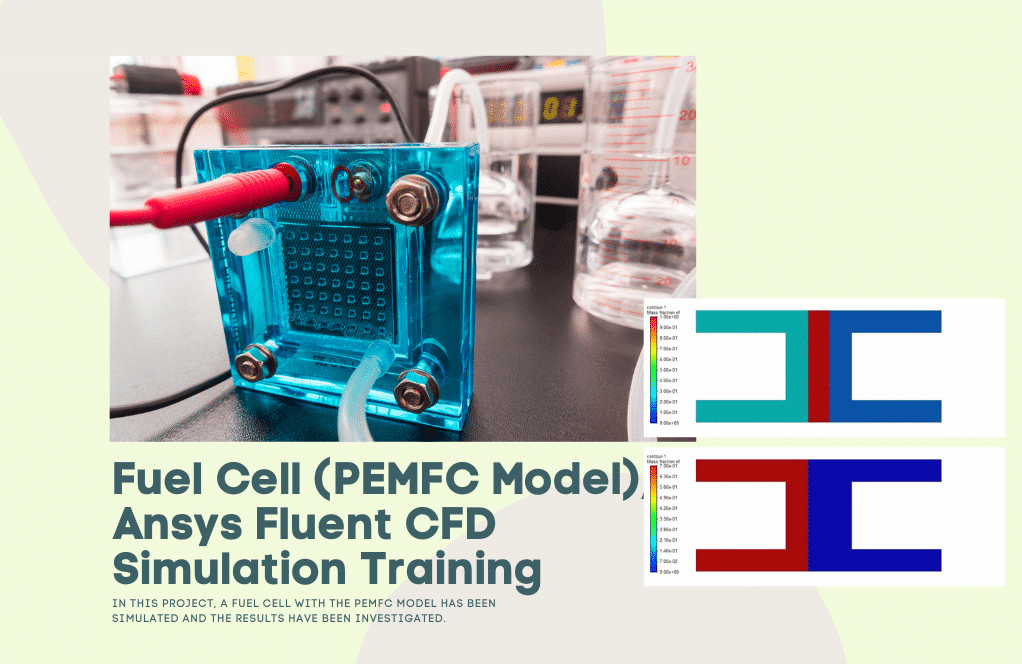
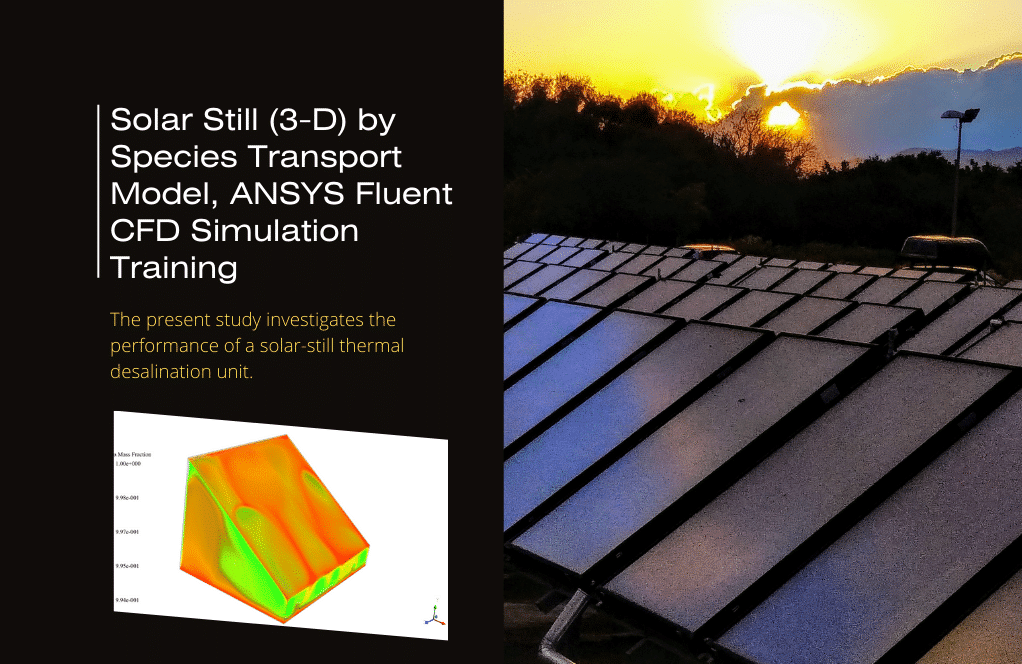
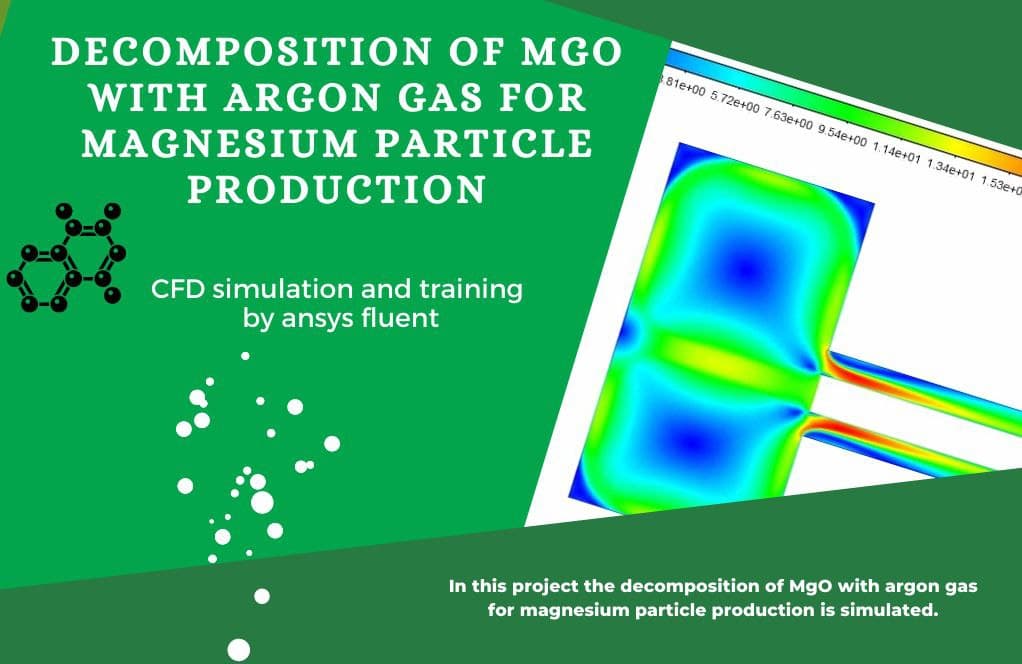
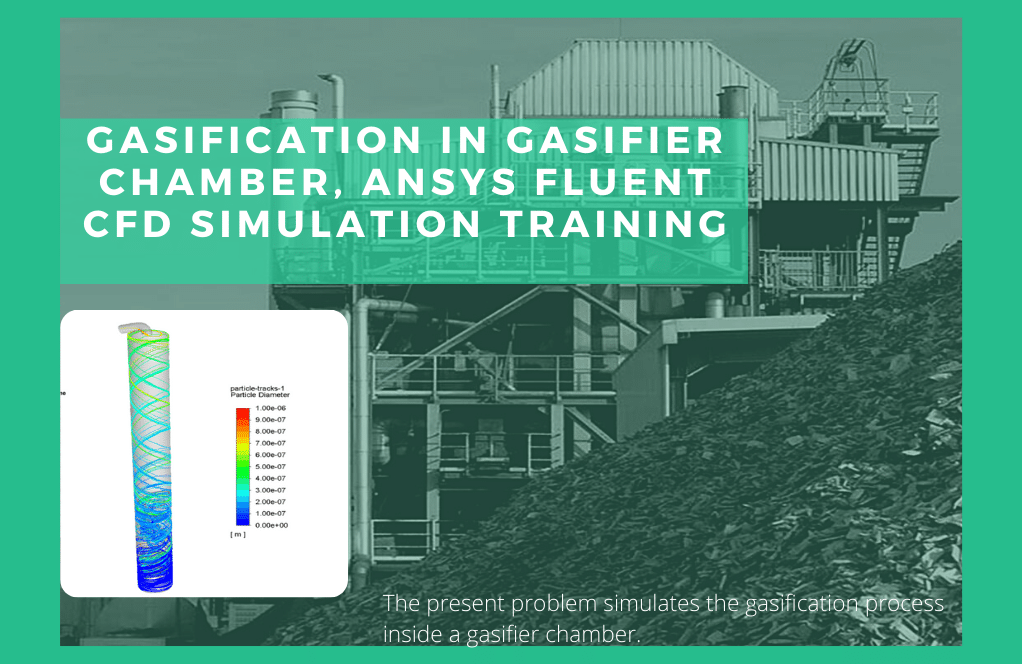

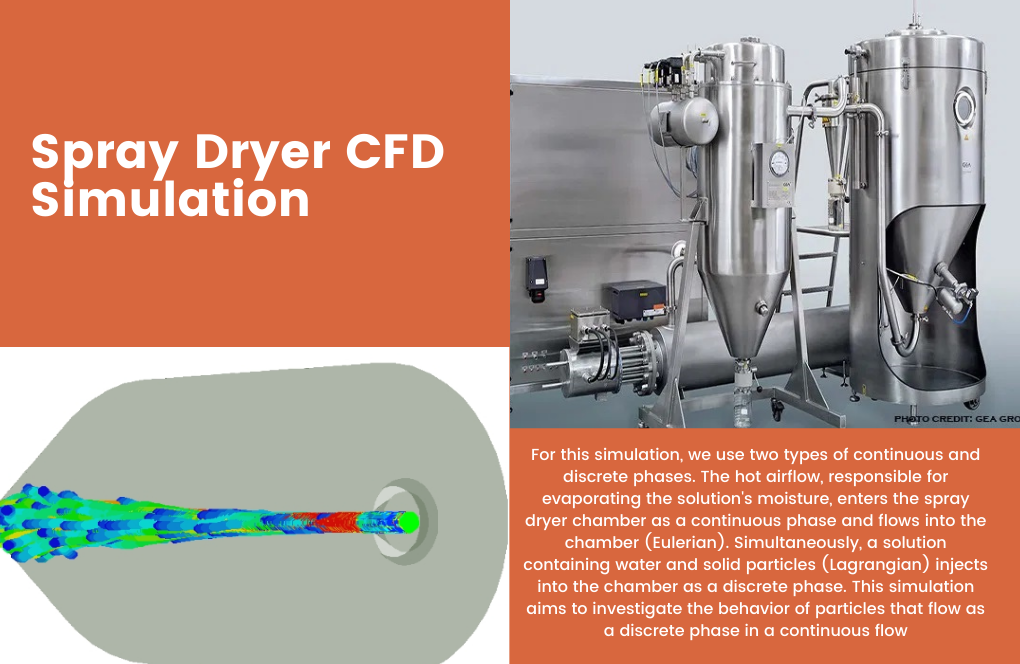
Elliott Kemmer –
This training package seems quite comprehensive for intermediate users. I’d like to specifically know how the two-way DPM is calibrated in the coffee shop model to ensure the results reflect realistic virus particle spread.
MR CFD Support –
In the coffee shop model, the two-way DPM calibration takes into account factors like the initial velocity of the cough droplets, the size distribution of the droplets, and evaporation rates to mimic the real-life scenario of virus spread. The DPM calculates the trajectory of particles based on these factors and their interaction with the continuous phase airflow in the coffee shop.
Prof. Scarlett Kassulke II –
The Species Transport Training Package actually helped me to better understand complex CFD problems. I particularly appreciated the variety of examples provided, from COVID-19 spread simulations to combustion processes. The step-by-step tutorials and logical progression through the topics gave me a clearer understanding of when and how to apply different species transport methods in ANSYS Fluent.
MR CFD Support –
Thank you so much for your kind words. We are thrilled to hear that our Species Transport Training Package has contributed to your understanding of CFD problems using ANSYS Fluent. It’s great to know that the variety and depth of the exercises met your needs. If you ever have more feedback or need further assistance, feel free to reach out!
Alejandrin Langosh DDS –
This Species Transport Training Package has thoroughly enhanced my understanding of ANSYS Fluent’s capabilities. I particularly appreciated the variety of exercises that exposed me to different industry-relevant scenarios. It’s clear that a lot of thought went into structuring these exercises to gradually build on each other, which demystified many of the concepts I found intimidating at first.
MR CFD Support –
Thank you for your positive feedback. We’re delighted to hear that our Species Transport Training Package for intermediate users has successfully guided you through complex simulations in ANSYS Fluent and made the concepts approachable. Your appreciation truly motivates us to keep producing quality educational material for our learners.
Luis Kutch –
I am utterly pleased with the Species Transport Training Package I purchased. The 10 exercises provided a clear progression of complexity and skill development, expanding my understanding of both the software and species transport phenomena greatly. I must say, the practical examples were thoughtfully selected, covering a variety of relevant cases from coronavirus particle study to combustion and desalination analysis. The included training movies were a valuable supplement; they served as a detailed visual guide through every step in the CFD process within ANSYS Fluent. Seeing applications such as a solar still for desalination and the dynamics of airflow in spaces sensitive to virus spread, like elevators and cars, was especially insightful. Furthermore, the theory and methodology explanations were concise and informative. I’m confident in my ability to begin average species transport simulations independently now, and I’m looking forward to Part 2 of this package.
MR CFD Support –
We truly appreciate your detailed review and are thrilled to learn about your satisfaction with the intermediate Species Transport Training Package. It’s fantastic to see you’ve gained confidence in your CFD simulation abilities and found the variety of cases both informative and relevant to real-world applications. Stay tuned for Part 2, and don’t hesitate to reach out if you have any more questions as you deepen your expertise with ANSYS Fluent. Thank you for choosing our training package!
Nola Rice –
The Species Transport Training Package seems to really offer comprehensive knowledge! I was particularly impressed with how the exercises were applied to real-world scenarios, enhancing my understanding of virus particle dispersion in various contexts and combustion processes. The detailed explanations aided not just in operating the software, but also in grasping the underlying physics of these phenomena. Keep up the great work!
MR CFD Support –
We’re truly delighted to know that you’ve found the Species Transport Training Package enlightening and applicable to real-life cases, especially in better understanding the spread of virus particles and the mechanics of combustion. Our goal is to provide an educational experience that is at once theoretical and practical. Thank you for taking the time to share your positive experience with us!
Gerard Jones –
The Species Transport Training Package was really comprehensive, with practical exercises that visualized the theories nicely, especially within crowdy settings like elevators or cars which relate to everyday impact assessments. The examples selected, combined with the teaching format, kept me engaged throughout the learning process.
MR CFD Support –
We’re delighted to hear that our Species Transport Training Package met your expectations and that you found the exercises both practical and engaging. It’s great to know the real-world scenarios we covered helped you understand the impact of species transport. Thank you for your feedback!
Dr. Derrick Schaefer PhD –
The Species Transport Training Package seems incredibly comprehensive. As someone who deals with CFD regularly, I now have a better insight into the application of species transport models in various scenarios, such as virus particle spread and combustion processes. This training not only educators but also gears up professionals like myself to handle complex simulations with confidence.
MR CFD Support –
We are thrilled to hear that you found our Species Transport Training Package to be comprehensive and useful. It’s great to know that it has provided you with the insights and confidence needed to carry out complex species transport simulations. Thank you for choosing our training package, and we look forward to supporting your CFD journey further!
Benedict Johnston V –
The Species Transport Training Package seems quite comprehensive. I’m especially intrigued by the solar still thermal desalination unit in project number 9. Could you provide a bit more insight into how the simulation of the evaporation process within the solar still is set up?
MR CFD Support –
In project number 9 regarding the solar still thermal desalination unit, the evaporation process is simulated by applying a User-Defined Function (UDF) in ANSYS Fluent to model surface evaporation effectively. The UDF allows for the precise calculation of the rate of evaporation based on factors such as solar intensity, fluid temperature, and the thermodynamic properties of water. The energy from the sun that passes through the sloping glass is absorbed by the water, causing it to evaporate. The vapor then condenses on the colder glass surface, enabling the collection of purified distilled water. This simulation takes into account the heat transfer through convection and radiation, as well as the mass transfer due to the phase change from liquid to gas.
Arnoldo Waters III –
The Species Transport Training Package seems comprehensive. Can you please explain how simulation no. 2 differs when using the plastic cover versus not using it? How does it affect the spread of the virus particles?
MR CFD Support –
The presence of the plastic cover in simulation no. 2 changes the flow pattern and particle trajectory within the bank space. With the cover, the virus particles’ diffusion towards the bank employee is expected to reduce considerably as the cover acts as a physical barrier, thus showing the effectiveness of protective measures in such an environment.
Mrs. Mireya Marvin Jr. –
I’ve gone through the Species Transport Training Package. It wonderfully displays a broad spectrum of applications. Could you give more insight into how the numerical simulation of the fuel cell in project #8 is validated against experimental data or any existing benchmarks?
MR CFD Support –
Admin note: We’re glad to share that for the fuel cell simulation in project #8, the numerical results are validated through comparison with data gathered from scientific literature and real experimentation on a PEMFC model. This ensures accuracy and reliability of our CFD simulations.
Ms. Elnora Donnelly II –
The secondary projects, particularly the combustion and desalination simulations, seem complex. I would like to know if the training package includes step-by-step tutorials that cover the selection of suitable models and boundary conditions for specific applications like these.
MR CFD Support –
Yes, the Species Transport Training Package includes comprehensive tutorials that provide step-by-step instructions. These cover the selection of the appropriate models, such as species transport for combustion or evaporation in desalination processes, setting up boundary conditions, and defining materials and phase interactions tailored for each simulated scenario. This ensures users are equipped with the proper knowledge to execute complex simulations with confidence.
Fabiola Durgan –
I just worked through the Species Transport Intermediate Part 1 package and found it extremely useful! The exercises were perfectly paced, and the variety of simulations from human cough virus particles in a coffee shop scenario to the analysis of combustion in a boiler gave me a well-rounded perspective. The inclusion of current topics like the spread of the coronavirus in various settings was also very insightful. Having detailed tutorials with step-by-step instructions for applications ranging from virus dispersion to desalination and fuel cells kept me engaged. I particularly appreciated how relevant these exercises felt, with real-world applications that enhance understanding of the species transport model in ANSYS Fluent.
MR CFD Support –
Thank you so much for the thoughtful review! We are thrilled to hear that the Species Transport Intermediate Part 1 package met your expectations and provided you with valuables insights across a diverse range of simulations. It’s fantastic that you recognized the balance and relevance in our training materials. We aim to provide comprehensive and current exercises that directly apply to real-world challenges. Your engagement and appreciation motivate us to keep delivering top-notch CFD resources. If you have any further questions or need assistance as you continue learning, do not hesitate to reach out!
Prof. Kariane Conroy –
Just finished the Intermediate Part 1 of the Species Transport Training Package and it’s fantastic! The range of exercises from COVID-19 spread simulations to combustion and desalination projects gave me a comprehensive insight into various applications of species transport in ANSYS Fluent. Every exercise enhanced my understanding of real-world physics and improved my skill in setting up complex simulations. Particularly impressive was the clear guidance on using DPM along with species transport. The inclusion of detailed tutorials for each exercise made the learning curve much easier to manage. Well done MR CFD!
MR CFD Support –
Thank you so much for your wonderful review! We are thrilled to hear that the Intermediate Part 1 of the Species Transport Training Package has been such an enriching experience for you. It’s great to know that the exercises across different applications were both informative and effective in enhancing your CFD simulation skills. We aim to deliver clear, comprehensive guidance to ensure our users can tackle complex simulations with confidence. Your feedback is greatly appreciated and motivates us to keep providing high-quality learning products. We look forward to hearing more about your progress and successes. Keep up the great work!
Alberta Cormier –
I have recently started working with CFD simulations for species transport applications, and I just completed the intermediate part 1 training package from MR CFD Company. I found the series of exercises to be practical and reflective of the real-world scenarios, especially the simulations related to virus particle dispersion in various environments such as the coffee shop and elevator cabin using the discrete phase model. The juxtaposition of cases with and without protective barriers provided invaluable insights. The combustion exercises and the desalination project have significantly contributed to my understanding of related processes. The use of UDF for complex phenomena like surface evaporation was particularly enlightening. Thank you for a well-structured and insightful training package.
MR CFD Support –
Thank you very much for the kind words regarding our Species Transport Training Package for intermediate users. We are pleased to hear that you found the practical exercises useful and applicable to real-world scenarios. It’s great to know that the projects have deepened your understanding of virus dispersion, combustion, and desalination processes in CFD. We pride ourselves on providing relevant and detailed content to help our learners grasp complex concepts, and we’re delighted that our training has added value to your studies. Your feedback is much appreciated, and we look forward to your continued learning with MR CFD Company.
Miss Kristy Rippin –
Just finished Project 3 on coronavirus particle dispersion in an elevator cabin. The outcomes were fascinating! I was impressed by the clarity of given instructions and the complexity of the simulation. Great educational resource!
MR CFD Support –
We’re thrilled to hear that you found the Project 3 on coronavirus particle dispersion simulation beneficial and educational! Thank you for the positive feedback, and we’re delighted our instructions were clear and helpful. Keep applying those skills, and don’t hesitate to reach out if you need any further assistance!
Dr. Tobin Hessel Jr. –
Each project sounds extremely relevant and packed with practical examples. I’m particularly interested in how effective the thin plastic cover was in preventing virus spread in the bank scenario. Great job!
MR CFD Support –
Thank you for sharing your thoughts! We are thrilled to hear that you find the projects engaging and relevant. Your curiosity around the effectiveness of the thin plastic cover in our virus spread simulations reflects the kind of insightful engagement we hope to inspire with our exercises. We appreciate your recognition of the work that goes into creating these comprehensive simulations.
Albina Hane IV –
The Species Transport Training Package I’ve worked through is exceptional. The simulation of viral spread in public places and combustion processes provided a keen insight into safe environmental practices and energy systems. The step-by-step application of the DPM and species transport model in especially practical scenarios like the Coffee Shop or the Elevator Cabin projects illustrated the complexities involved in predicting particle behavior in enclosed spaces. Moreover, the last project’s execution around decomposition coupled with particle reaction affirms how versatile this entire package is for users vested in understanding and applying principles of species transport in diverse contexts.
MR CFD Support –
We truly appreciate your thorough and reflective review of our Species Transport Training Package for INTERMEDIATE users. It is heartening to know that the practical exercises have meaningfully contributed to your understanding of species transport dynamics and their applications in various scenarios including health safety, energy systems, and complex environmental simulations. Your acknowledgment of the package’s diversity in teaching particle behavior prediction and the incorporation of different CFD modeling techniques is the testament we strive for. Thank you for choosing our training package, and we encourage you to continue enriching your computational fluid dynamics skills with our advanced modules.
Ms. Magdalen Bayer DDS –
I thoroughly enjoyed project number 6 on burner combustion. The way the simulation combined convection and radiation, and especially how it managed to integrate the DO model with the species transport for an accurate portrayal of the combustion process within the chamber, is commendable. Also, I appreciate the inclusion of multiple species and reactions, which made understanding complex combustion dynamics much clearer.
MR CFD Support –
Thank you for your positive feedback on our Species Transport Training Package, specifically regarding project number 6. It’s great to hear that our approach to simulating combustion with comprehensive species transport and the integration of the DO model for radiation helped clarify complex dynamics. We’re glad that you found the insights on convection and radiation flow in burners educational and that you appreciate the detailed representation within the chamber. We strive to deliver valuable and in-depth training, and your satisfaction is a wonderful testament to our efforts. If you have any further questions or need assistance with other projects, please do not hesitate to reach out.